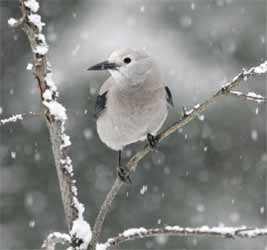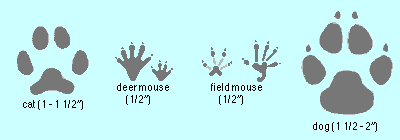How Do Animals Spend the Winter?
Learn how animals spend the winter with these 4 easy science projects.

NOTE: ADULT SUPERVISION IS REQUIRED. Please read all instructions completely before starting. Observe all safety precautions.
Table of Contents
Project 1 - Feed and observe winter birds and animals
What you need:
- Some or all of the following: popcorn, peanuts in shells, apples, cranberries, pears, oranges, kiwi, peanut butter, suet (from butcher)
- String, needle and strong thread, scissors, knife
- Pine cone (to use with peanut butter), onion bag (to use with suet)
What to do:
- String the popcorn and cranberries on a long, doubled piece of thread. String the whole peanuts on another thread.
- Slice the fruit crosswise, about 1/4-1/2 inch thick. Poke a hole about 2/3 of the way across each slice, thread a 12 inch piece of string through it and tie the ends together.
- Put peanut butter or suet into the holes in a pine cone. Tie a string to it.
- Cut suet into large pieces and put it into an onion bag.
- Hang the food from trees and bushes in sheltered areas, where you can see it. Be patient. It takes time for birds and animals to find the food. Try different locations.
Note: If you choose to begin feeding the birds regularly, try to do it throughout the winter. They start to depend on you and may have trouble finding other sources of food later in the season.
Project 2 - Feed and observe winter birds
What you need:
- An empty plastic milk or water bottle, or a milk carton
- Scissors, string, bird seed
What to do:
- Wash the bottle or carton and rinse it well.
- Cut several small holes in the sides, about 2" from the bottom.
- Cut or poke two small holes near the top and thread a long piece of string through them.
- Fill the bird feeder with seeds and hang from a tree or shrub. Scattering some seeds on the ground can help the birds find the feeder.
- Watch the birds. Be patient.
- Try different types of seeds and different locations. Record your observations.
Project 3 - Discover how insects and spiders survive the winter
What you need:
- Warm clothes and a nice day
- flashlight, magnifying glass (helpful but not necessary)
- large glass jar or milk carton, potting soil, cheesecloth or old nylon stocking
- rubber band, knife or pruning shears
What to do:
- Go outside. Look into crevices in bark, in and under dead logs, piles of leaves, clumps of grass, shingles, around windows, in cracks between bricks, in attics, basements, garages, and any place that provides shelter. Use your flashlight and a stick for probing. Can you find active and hibernating adult insects, eggs, and cocoons? Try to leave things as you found them.
- Try to find a gall on a tree or shrub. Collect several different types. While still outside, cut them in half and observe what is inside.
- You can keep galls to see what emerges in the Spring. Cut a 4-6" section of a twig with a gall. Put a layer of potting soil into a jar, or a milk carton with holes cut in two sides. Put one end of the twigs into the dirt. Cover the jar with cheesecloth or stocking secured by a rubber band, or slide the milk carton into a stocking and tie the ends. Moisten the dirt occasionally. Keep the galls outdoors, out of direct sunlight.
Project 4 - Study animal tracks

What you need:
- Animal tracks in snow or mud
- animal footprints shown on the right
What to do:
- Study tracks in the snow or mud and try to match them to the drawings. (Sizes listed are approximate.)
- What animals were there? Are the tracks closely spaced or far apart? Were the animals walking or running? How many different animal tracks can you find? Keep a record over time.
How Do Animals Survive the Winter?
Animals have many different winter survival strategies, including migration, adaption and hibernation...


